
Mechanical Clutch
All rotary hammer drills are equipped with a torque limiting clutch that reduces the maximum torque
reaction transmitted to the operator in case of jamming of a drill bit. This feature also prevents the
gearing and electric motor from stalling. The torque limiting clutch has been factory-set and cannot
be adjusted.
Side Handle (Fig. 2)
WARNING: To reduce the risk of personal injury, ALWAYS operate the tool with the side handle
properly installed and securely tightened. Failure to do so may result in the side handle slipping
during tool operation and subsequent loss of control. Hold tool with both hands to maximize control.
A side handle comes assembled with this rotary hammer. The side handle (H) can be fitted to suit
both right-hand and left-hand users.
TO ADJUST THE SIDE HANDLE
1. Loosen the side handle (H) by turning it counterclockwise.
2. Rotate the side handle to the desired position.
3. Tighten the side handle by turning it clockwise.
Trigger Switch (Fig. 1)
To start the rotary hammer, depress the variable speed trigger switch (A). To stop rotary hammer,
release the switch.
NOTE: Use lower speeds for starting holes without a centerpunch, drilling in metal, plastics or
ceramics, or driving screws. Higher speeds are better for drilling in masonry for maximum effi ciency.
VARIABLE SPEED
The variable speed trigger switch (A) permits speed control. The farther the trigger switch is
depressed, the higher the speed of the drill.
Forward/Reverse Lever (Fig. 1)
The forward/reverse lever (C) is used to reverse the rotary hammer for backing out fasteners or
jammed bits in drill-only mode.
CAUTION: When reversing to clear jammed bits, be ready for strong reactive torque.
To reverse the rotary hammer, turn it off and align the forward/reverse lever (C) with the yellow arrow
pointing backward (viewed when holding drill in operating position).
To position the lever for forward operation, turn the rotary hammer off and align the forward/reverse
lever (C) with the yellow arrow pointing forward (viewed when holding drill in operating position).
Mode Selector (Fig. 3)
D25133, D25260, D25262, D25263
WARNING: Do not operate in drill or hammerdrill mode with a chisel bit in the chuck. Personal
injury and damage to tool may result.
NOTICE: Tool must come to a complete stop before activating the mode selector button or damage
to the tool may result.
DRILL-ONLY MODE
To use drill-only mode, press mode selector button (E) and turn the mode selector (D) so the yellow
arrow points to the corresponding symbol as shown. Use drill-only mode for wood, metal, and
plastics.
HAMMERDRILL MODE
To use hammerdrill mode, press the mode selector button (E) and turn the mode selector (D) so the
yellow arrow points to the corresponding symbol as shown. Use this mode for masonry drilling.
HAMMER-ONLY MODE
For light chiseling, press the mode selector button (E) and turn the mode selector (D) so the yellow
arrow points to the corresponding symbol as shown.
NOTE: The yellow arrow on the mode selector MUST be aligned with the one of the symbols at all
times. There are no operable positions between the positions.
SDS Plus Chuck (Fig. 1)
WARNING: To reduce the risk of serious personal injury, turn tool off and disconnect tool
from power source before making any adjustments or removing/installing attachments or
accessories.
WARNING: Burn Hazard. ALWAYS wear gloves when changing bits. Accessible metal parts on
the tool and bits may get extremely hot during operation. Small bits of broken material may damage
bare hands.
WARNING: Do not attempt to tighten or loosen drill bits (or any other accessory) by gripping the
front part of the chuck and turning the tool on. Damage to the chuck and personal injury may occur.
To insert bit, insert shank of bit about 3/4" (19 mm), no further than 7/8" (24 mm) into chuck (F).
Push and rotate bit until it locks in place. The bit will be securely held.
To release bit, pull the chuck sleeve (F) back and remove the bit.
OPERATION
WARNING: To reduce the risk of injury, turn unit off and disconnect it from power source
before installing and removing accessories, before adjusting or when making repairs. An
accidental start-up can cause injury.
WARNING: To reduce the risk of personal injury, ALWAYS ensure workpiece is anchored
or clamped fi rmly. If drilling thin material, use a wood “back-up” block to prevent damage to the
material.
WARNING: To reduce the risk of personal injury, ALWAYS operate the tool with the side
handle properly installed and securely tightened. Failure to do so may result in the side handle
slipping during tool operation and subsequent loss of control. Hold tool with both hands to maximize
control.
Proper Hand Position (Fig. 1, 4)
WARNING: To reduce the risk of serious personal injury, ALWAYS use proper hand position as
shown.
WARNING: To reduce the risk of serious personal injury, ALWAYS hold securely in anticipation
of a sudden reaction.
Proper hand position requires one hand on the side handle (H), with the other hand on the main
handle (B).
Drilling Tools
The machine is intended for hammerdrilling in concrete, brick and stone. It is also suitable for drilling
without impact in wood, metal, ceramic and plastic.
Chipping Tools
The machine is intended for chipping in concrete, brick and stone.
Drilling
Press mode selector button (E) and turn the mode selector (D) to the drill bit symbol for drilling, to the
hammer symbol for hammering or to the hammerdrill symbol for hammerdrilling.
DRILLING OPERATION
1. For WOOD, use twist bits, spade bits, power auger bits or hole saws. For METAL, use high-speed
steel twist drill bits or hole saws. Use a cutting lubricant when drilling metals. The exceptions
are cast iron and brass which should be drilled dry. For MASONRY, use carbide-tipped bits or
masonry bits. A smooth, even fl ow of dust indicates the proper drilling rate.
2. Always apply pressure in a straight line with the bit. Use enough pressure to keep the drill bit
biting, but do not push hard enough to stall the motor or defl ect the bit.
3. Hold tool fi rmly with both hands to control the twisting action of the drill.
WARNING: Drill may stall if overloaded causing a sudden twist. Always expect the stall. Grip
the drill fi rmly with both hands to control the twisting action and avoid injury.
4. IF DRILL STALLS, it is usually because it is being overloaded. RELEASE TRIGGER
IMMEDIATELY, remove drill bit from work, and determine cause of stalling. DO NOT CLICK
TRIGGER OFF AND ON IN AN ATTEMPT TO START A STALLED DRILL – THIS CAN
DAMAGE THE DRILL.
5. To minimize stalling or breaking through the material, reduce pressure on drill and ease the bit
through the last fractional part of the hole.
6. Keep the motor running when pulling the bit back out of a drilled hole. This will help prevent
jamming.
7. With variable speed drills there is no need to center punch the point to be drilled. Use a slow
speed to start the hole and accelerate by squeezing the trigger harder when the hole is deep
enough to drill without the bit skipping out.
DRILLING IN METAL
An SDS Plus round shank adaptor chuck is required for metal drilling. Ensure that tool is in drill-only
mode. Start drilling with slow speed and increase to full power while applying fi rm pressure on the
tool. A smooth even fl ow of metal chips indicates the proper drilling rate. Use a cutting lubricant
when drilling metals. The exceptions are cast iron and brass which should be drilled dry.
NOTE: Large (5/16" to 1/2" [7.9 mm to 12.7 mm]) holes in steel can be made easier if a pilot hole
(5/32" to 3/16" [4 mm to 4.8 mm]) is drilled fi rst.
DRILLING IN WOOD
An SDS Plus round shank adaptor chuck is required for drilling in wood. Ensure that tool is in drill-only
mode. Start drilling with slow speed and increase to full power while applying fi rm pressure on the
tool. Holes in wood can be made with the same twist drills used for metal. These bits may overheat
unless pulled out frequently to clear chips from the fl utes. For larger holes, use spade bits, power
auger bits, or hole saws. Work that is apt to splinter should be backed up with a block of wood.
HAMMERDRILL OPERATION
1. When drilling, use just enough force on the hammer to keep it from bouncing excessively or
“rising” off the bit. Too much force will cause slower drilling speeds, overheating, and a lower
drilling rate.
2. Drill straight, keeping the bit at a right angle to the work. Do not exert side pressure on the bit
when drilling as this will cause clogging of the bit fl utes and a slower drilling speed.
3. When drilling deep holes, if the hammer speed starts to drop off, pull the bit partially out of the
hole with the tool still running to help clear debris from the hole.
4. For masonry, use carbide-tipped bits or masonry bits. A smooth even fl ow of dust indicates the
proper drilling rate.
FIG. 5
I
G
H
FIG. 1
H
FIG. 2
Chipping and Chiseling (Fig. 1)
WARNING: Do not operate in drill or hammerdrill mode with a chisel bit in the chuck. Personal
injury and damage to tool may result.
1. Insert chisel while in hammerdrill mode and rotate to desired position.
2. Set the mode selector (D) to the hammer-only position.
3. Adjust the side handle (H) as required.
4. Switch on the tool and start working.
5. Always switch off the tool when work is finished and before unplugging.
Depth Rod (Fig. 5)
TO ADJUST THE DEPTH ROD
1. Push in and hold the depth rod release button (I) on the side handle.
2. Move the depth rod (G) so the distance between the end of the rod and the end of the bit equals
the desired drilling depth.
3. Release the button to lock rod into position. When drilling with the depth rod, stop when end of
rod reaches surface of material.
MAINTENANCE
WARNING: To reduce the risk of injury, turn unit off and disconnect it from power source
before installing and removing accessories, before adjusting or when making repairs. An
accidental start-up can cause injury.
Cleaning
WARNING: Blow dirt and dust out of all air vents with clean, dry air at least once a week. To
minimize the risk of eye injury, always wear ANSI Z87.1 approved eye protection when performing
this.
WARNING: Never use solvents or other harsh chemicals for cleaning the non-metallic parts of the
tool. These chemicals may weaken the plastic materials used in these parts. Use a cloth dampened
only with water and mild soap. Never let any liquid get inside the tool; never immerse any part of the
tool into a liquid.
Lubrication
Your tool was properly lubricated before leaving the factory. In from two to six months, depending
upon use, take or send your tool to an authorized service center for a complete cleaning, inspection
and lubrication. Tools used constantly on production jobs will need relubrication more often. Also,
tools “out of service” for long periods should be relubricated before being put back to work.
Accessories
WARNING: Since accessories, other than those offered by DEWALT, have not been tested with
this product, use of such accessories with this tool could be hazardous. To reduce the risk of injury,
only D
EWALT recommended accessories should be used with this product.
Recommended accessories for use with your tool are available at extra cost from your local dealer or
authorized service center. If you need assistance in locating any accessory, please contact D
EWALT
Industrial Tool Co., 701 East Joppa Road, Towson, MD 21286, call 1-800-4-D
EWALT (1-800-433-
9258) or visit our website: www.dewalt.com.
MAXIMUM RECOMMENDED CAPACITIES
D25260 D25133, D25262 D25263
Masonry 7/8" (24 mm) 1" (26 mm) 1-1/8" (28 mm)
Masonry
Optimum Capacity
3/16"–1/2"
(5 mm–13 mm)
1/4"–5/8"
(6 mm–16 mm)
1/4"–3/4"
(6 mm–19 mm)
Repairs
To assure product SAFETY and RELIABILITY, repairs, maintenance and adjustment (including brush
inspection and replacement) should be performed by a DEWALT factory service center, a DEWALT
authorized service center or other qualifi ed service personnel. Always use identical replacement
parts.
G
F
D25133
FIG. 3
DRILL-ONLY MODE
MODE PERÇAGE SEULEMENT
MODO SÓLO TALADRO
HAMMERDRILL MODE
MODE PERFORATION-PERÇAGE
MODO TALADRO/PERCUTOR
CHISEL ROTATION
ROTATION DU BURIN
ROTACIÓN DE CINCELES
HAMMER-ONLY MODE
MODE PERFORATION SEULEMENT
MODO SÓLO MARTILLO
(D25133, D25260, D25262, D25263)
I
B
D
E
C
H
J
C
B
D
E
I
H
F
J
G
D25263
E
D
A
A
FIG. 4
K

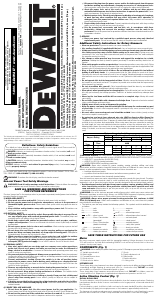


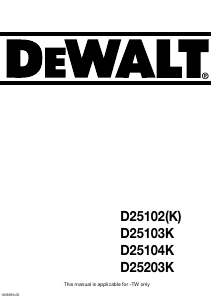
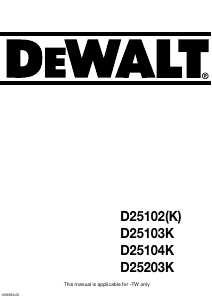
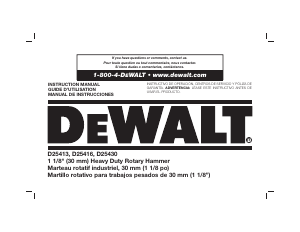
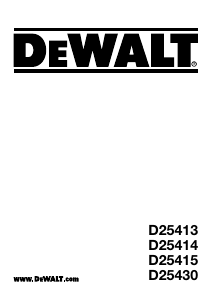
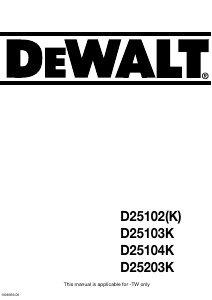
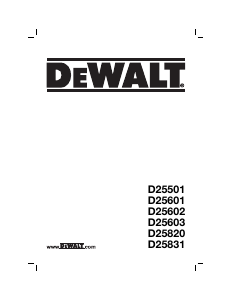

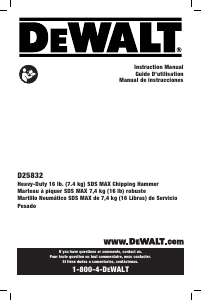
Join the conversation about this product
Here you can share what you think about the DeWalt D25263K Rotary Hammer. If you have a question, first carefully read the manual. Requesting a manual can be done by using our contact form.